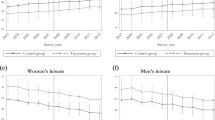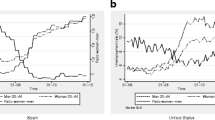Abstract
This paper provides an empirical investigation on the individual labor supply of Iranian spouses in an intra-household collective decision framework in which gender ratio and divorce rate play a central role for resource allocation of household. The dataset is taken from the Households’ Expenditures Survey (2008) and the Annual Statistical Yearbook (2008) of Iran. I have conducted the parameters estimation and hypothesis testing using switching regression technique to catch the presence of the widespread non-participation of spouses across Iranian households. Reduced forms of labor supply are estimated considering the endogeneity of wage rates. The findings show that the unitary model of resource allocation and the collective model of decision process under Iranian civil procedure rules are strongly rejected, but the Pareto efficiency in the family resource allocation and validity of the specified model are confirmed. Furthermore, the coherency condition of labor supply reduced forms is satisfied. The structural labor supplies are derived from the reduced forms, and they indicate that leisure is a normal good for spouses. They also show the cross elasticity of a wife’s labor supply with respect to her husband’s wage is negative. The calculated marginal effect of non-labor income on the wife’s share is 0.76. The gender ratio and the divorce rate are both significant determinants of the sharing rule and the estimated coefficients of these variables are consistent with theoretical considerations.








Similar content being viewed by others
Notes
According to the civil procedures of Iran, groom should accept a commitment according which he should pay a dower upon to request of the bride during their life or when she wants to get divorce. The dower usually is determined by real estate or golden coins which by norm amounts to 250 ounce. Moreover, if the divorce is initiated by husband, he should pay half of all their properties and assets to his wife.
In a well-described survey, (Xu 2007) categorizes the intra-household models and its empirical evidence.
Note that housewives and students are excluded from the sample, and all individuals with non-zero working hour are considered as employed.
References
Altonji JG, Hayashi F, Kotlikoff LJ (1993) Is the extended family altruistically linked? direct tests using micro data. Technical report, National Bureau of Economic Research, Cambridge
Apps PF, Rees R (1988) Taxation and the household. J Public Econ 35(3):355–369
Ashworth, JS, Ulph DT (1981) Endogeneity I: estimating labour supply with piecewise linear budget constraints. In: Brown CV (ed) Taxation and labour supply. George Allen and Unwin, London p 53–68
Basu K (2006) Gender and say: a model of household behaviour with endogenously determined balance of power*. Econ J 116(511):558–580
Bloemen HG (2010) An empirical model of collective household labour supply with non-participation. Econ J 120(543):183–214
Bloemen HG, Stancanelli EGF (2005) Financial wealth, consumption smoothing and income shocks arising from job loss. Economica 72(287):431–452
Blundell R, Chiappori P-A, Magnac T, Meghir C (2007) Collective labour supply: heterogeneity and non-participation. Rev Econ Stud 74(2):417–445
Bourguignon F, Browning M, Chiappori P-A, Lechene V (1993) Intra household allocation of consumption: a model and some evidence from french data. Ann Econ Stat 29:137–156
Browning M (2000) The saving behaviour of a two-person household. Scand J Econ 102(2):235–251
Browning M, Bourguignon F, Chiappori P-A, Lechene V (1994) Income and outcomes: a structural model of intrahousehold allocation. J Political Econ 102:1067–1096
Browning M, Chiappori P-A (1998) Efficient intra-household allocations: a general characterization and empirical tests. Econometrica 66:1241–1278
Chau TW, Li H, Liu PW, Zhang J (2007) Testing the collective model of household labor supply: evidence from china. China Econ Rev 18(4):389–402
Chen Z, Woolley F (2001) A cournot–nash model of family decision making. Econ J 111(474):722–748
Chiappori P-A (1988) Rational household labor supply. Econometrica J Econ Soc 56:63–90
Chiappori P-A (1992) Collective labor supply and welfare. J Political Econ 100:437–467
Chiappori P-A, Ekeland I (2006) The micro economics of group behavior: general characterization. J Econ Theory 130(1):1–26
Chiappori P-A, Fortin B, Lacroix G (2002) Household labor supply, sharing rule and the marriage market. J Political Econ 110(1):37–72
Chiappori P-A, Fortin B, Lacroix G (2002) Marriage market, divorce legislation, and household labor supply. J Political Econ 110(1):37–72
Cho D, Cho J, Song B (2010) An empirical analysis of the gender earnings gap between the public and private sectors in Korea: a comparative study with the US. J Jpn Int Econ 24(3):441–456
Clark A, Couprie H, Sofer C (2004) La modélisation collective de l’offre de travail. Rev Econ 55(4):767–789
Crespo L (2005) Estimation and testing of household labour supply models: evidence from Spain. Citeseer, Barcelona
Donni O (2003) Collective household labor supply: nonparticipation and income taxation. J Public Econ 87(5):1179–1198
Fernandez-Val I (2003) Household labor supply: evidence for Spain. Investig Econ 27(2):239–275
Fortin B, Lacroix G (1997) A test of the unitary and collective models of household labour supply*. Econ J 107(443):933–955
Hausman JA, Ruud P (1984) Family labor supply with taxes. Am Econ Rev 74:242–248
Hourriez J-M(2005). Estimation of a collective model of labor supply with female nonparticipation. CREST-INSEE mimeo
Johnson WR, Skinner J (1986) Labor supply and marital separation. Am Econ Rev 438:455–469
Keshavarz-Haddad GR, Mohit S (2012) Dual job holding in Iran. Tahghighat-e-eghtesadi 47:85–108
Koolwal GB, Ray R (2002) Estimating the endogenously determined intrahousehold balance of power and its impact on expenditure pattern: evidence from Nepal, vol 2814. World Bank, Office of the Senior Vice President, Development, Economics
Lacroix G, Radtchenko N (2011) The changing intra-household resource allocation in Russia. J Popul Econ 24(1):85–106
Leuthold JH (1968) An empirical study of formula income transfers and the work decision of the poor. J Hum Resour 3:312–323
Ligon E (2003) Dynamic intra-household bargaining (with an application to bangladesh). Unpublished manuscript, UC Berkeley
Lundberg S, Pollak RA (1993) Separate spheres bargaining and the marriage market. J Political Econ 101:988–1010
Lundberg S, Pollak RA (1996) Bargaining and distribution in marriage. J Econ Perspect 10(4):139–158
Lundberg S, Rose E (1999) The determinants of specialization within marriage. School of Economics and Finance, University of Hong Kong, Hong Kong
Maitra P, Ray R (2003) The effect of transfers on household expenditure patterns and poverty in South Africa. J Dev Econ 71(1):23–49
Manser M, Brown M (1980) Marriage and household decision-making: a bargaining analysis. Int Econ Rev 21(1):31–44
McElroy MB (1990) The empirical content of nash-bargained household behavior. J Hum Resour 25: 559–583
McElroy MB, Horney MJ (1981) Nash-bargained household decisions: toward a generalization of the theory of demand. Int Econ Rev 22(2):333–349
Moreau N (2000) Une application d’un modèle collectif d’offre de travail sur données françaises. Économie prévision 146(5):61–71
Stevenson B (2008) Divorce law and women’s labor supply. J Empir Leg Stud 5(4):853–873
Ulph D (1989) A general non-cooperative Nash model of household consumption behaviour. Johann Wolfgang Goethe-Universität, Frankfurt
Xu Z (2007) A survey on intra-household models and evidence
Author information
Authors and Affiliations
Corresponding author
Rights and permissions
About this article
Cite this article
Haddad, G.K. Gender ratio, divorce rate, and intra-household collective decision process: evidence from iranian urban households labor supply with non-participation. Empir Econ 48, 1365–1394 (2015). https://doi.org/10.1007/s00181-014-0828-4
Received:
Accepted:
Published:
Issue Date:
DOI: https://doi.org/10.1007/s00181-014-0828-4




